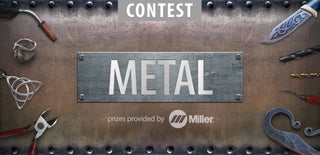Introduction: Homemade Knife From a File
This is my first instructable so bear with me. I made this knife from an old file I bought at a yard sale.
I can't be right all the time if you know how to do something better please leave a comment below.
I'm trying to leave this as open to customization as possible so that the knife will be unique to you, so change what you want designs, size, material etc.
WHEN I WRITE LIKE THIS I AM TRYING TO HELP YOU NOT MAKE THE MISTAKES THAT I DID
DISCLAIMER: you are making a knife which will hopefully be sharp it is not my fault if you cut yourself
Step 1: Temper Your File
so here I'm going to describe a technique I learned from a friend. to get a knife edge to stay sharp you have to harden it, I do not have the tools to do that efficiently, so I use a file which is already hard but it is too brittle to work with so we temper it
place your file in the oven at 400'F for about an hour and a half
MAKE SURE TO CLEAN YOUR KNIFE BEFORE THIS STEP, I DID NOT DO THIS WITH A FARRIERS RASP AND IT FILLED THE HOUSE WITH SMOKE
Step 2: Design Your Knife
The first step in making a knife is designing it. I draw mine out on paper but there are printable ones you can get for free. I like freehand because I can change the dimensions.
Trace the outline of the file on paper. then go to work. in my experience a 3 1/2 to 4in handle works best. blade length is your decision but personally I like smaller blade's
Step 3: Cut Out and Apply to File
cut out your drawing or printout and place on file use a marker to outline it on the file, you might have to clean it up a little to be able to see the marker
Step 4: Cut Out Shape
I use an angle grinder to cut out the file shape, clamp the knife and cut small pieces off
BE CAREFUL NOT TO OVERHEAT THE METAL IF YOU DO YOU'LL HAVE TO QUENCH IT LATER
Step 5: Profile the Blade
using the angle grinder and a 4x36in belt sander grind the profile of the blade to shape
BE CAREFUL NOT TO BURN THE BLADE A SMALL DARK SPOT IS FINE YOU CAN JUST GRIND IT AWAY BUT IF IT BURNS ALL THE WAY THROUGH YOU HAVE TO CUT IT OFF
Step 6: Put in Lines
useing a marker color your edge find a drill bit the same width as your file scratch a center line this is for reference later. now draw a line for your bevel this is also for reference
Step 7: Grind Bevel
using the belt sander and grinder put in your bevels watch those lines
KEEP YOUR BLADE COOL BY CONSTANTLY DIPPING IN A CUP OF WATER
Step 8: Find Pins
you can do a lot with this step you can go simple and use a nail or go fancy and order online i went to a hardware store and got some hollow spacers do what you want
Step 9: Find Handle Material
this is another step you can do a lot with you can use different materials wood micarta bone antler I use some wood I had laying around
Step 10: Soften Handle
we have kept the blade hard up till now but it is difficult to drill into hardened steel, to solve this place knife blade into a fireproof container of water. useing a torch heat the blade to red hot an let air cool
Step 11: Drill Holes in Handle
measure your holes mark them and drill this is easier with a drillpress but if you don't have one just concentrate on going up an down
Step 12: Clean Up Blade
after all the water dipping your blade will probably be rusty clean up by placing in an old cup full of vinegar
DO NOT LEAVE IN VINEGAR FOR MORE THAN 24 HOURS IT WILL BECOME PITTED AND IS VERY DIFFICULT TO FIX
Step 13: Handsand
this is optional after the vinegar your blade will have a dark tint you can leave this if you want. clean up by hand sanding the bevel gradually increasing grits
Step 14: Cut Handle Material
place knife handle on wood trace outline cut out profile making sure to stay outside the lines my wood was to thick so I cut it in half
Step 15: Drill Holes in Wood
clamp blade on wood drill holes making sure it won't wobble. switch piece and repeat
Step 16: Ruff Sand
push pins through holes sand handle outline and the top of the handle because it is hard to do after glueing
Step 17: File Work on Spine
this step is optional it will increase your grip and it looks cool
measure, mark, then clamp your knife. grind a small indentation then file the rest of the way
Step 18: Glue Handle Scales
sand handle with a ruff grit against the grain. put glue on handle and pins push pins through handle and blade put glue on other piece and push on. clamp and let sit overnight
Step 19: Sand Handle to Finish
finish sanding your handle profile to shape, then hand sand gradually increasing grits
Step 20: Finish Handle
I use colonial maple 223 stain on the handle but you can use whatever you want
Step 21: Sharpen Blade
use whatever you can to sharpen your knife. I used a kitchen knife sharpener
Step 22: Finished
here is the completed project.
please leave comment

Participated in the
Metal Contest 2016

Participated in the
Wood Contest 2016













